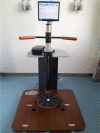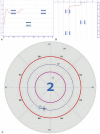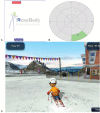Effects of visual feedback balance training with the Pro-kin system on walking and self-care abilities in stroke patients
- PMID: 32991477
- PMCID: PMC7523840
- DOI: 10.1097/MD.0000000000022425
Effects of visual feedback balance training with the Pro-kin system on walking and self-care abilities in stroke patients
Abstract
Some scholars' studies have demonstrated that Pro-kin balance system training is able to promote the recovery of the balance function in stroke patients. The present study has expanded on those studies, and was not merely limited to studying balance, but also encompassed walking and self-care abilities of the patients; furthermore, the association among balance and walking and self-care abilities was also explored.A total of 40 stroke patients were randomly and equally divided into 2 groups: the control group (n = 20) and the treatment group (n = 20). Both groups underwent conventional balance training, although the treatment group also underwent visual feedback balance training with the Pro-kin system. The balance function was assessed using the Berg Balance Scale (BBS), the Timed "Up & Go" (TUG) test, and Pro-kin system parameters. The Pro-kin system parameters included the perimeter and ellipse area, which were both tested once with eyes open (EO) and eyes closed (EC). Walking ability was assessed using the Holden Walking Ability Scale, according to the Functional Ambulation Classification (FAC). The self-care abilities were assessed with the Barthel Index (BI). The tests were conducted prior to training, and 3 weeks after the end of the training programme.No significant differences were noted among the groups before the training. After 3 weeks of training, for both the groups, significant improvements in balance and the walking and self-care abilities were noted: The BBS value was significantly increased (P < .05), whereas the TUG, perimeter, and ellipse area with EO and EC measurements were significantly decreased after treatment (P < .05). The FAC and BI readings were significantly increased after treatment (P < 0.05), and the treatment group outperformed the control group (P < .05). Furthermore, the balance function was shown to be strongly correlated with the walking and self-care abilities (P < .01).The present study has demonstrated that the use of the Pro-kin visual feedback balance training system in combination with conventional training is a viable method for improving walking and self-care abilities of stroke patients.
Conflict of interest statement
The authors have no conflicts of interest to disclose.
Figures
References
-
- Tu WJ, Dong X, Zhao SJ, et al. Prognostic value of plasma neuroendocrine biomarkers in patients with acute ischaemic stroke. J Neuroendocrinol 2013;25:771–8. - PubMed
-
- Loewen SC, Anderson BA. Predictors of stroke outcome using objective measurement scales. Stroke 1990;21:78–81. - PubMed
-
- Kwakkel G, Wagenaar RC, Kollen BJ, et al. Predicting disability in stroke—a critical review of the literature. Age Ageing 1996;25:479–89. - PubMed
-
- Lamb SE, Ferrucci L, Volapto S, et al. Risk factors for falling in home-dwelling older women with stroke: the Women's Health and Aging Study. Stroke 2003;34:494–501. - PubMed
Publication types
MeSH terms
LinkOut - more resources
Full Text Sources
Medical




